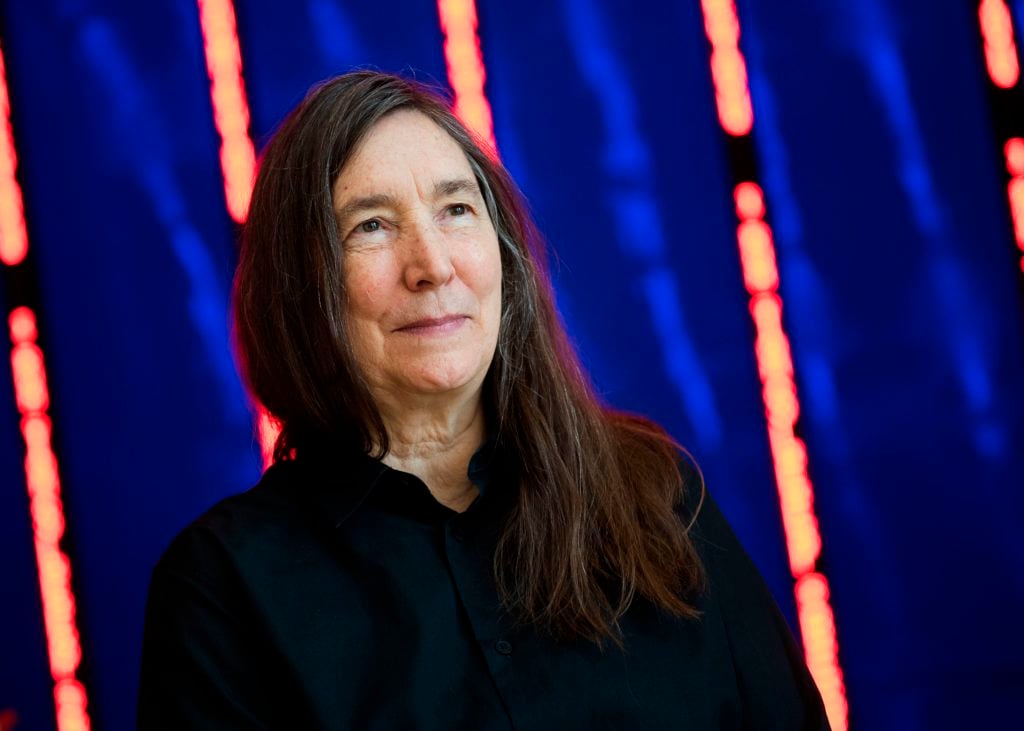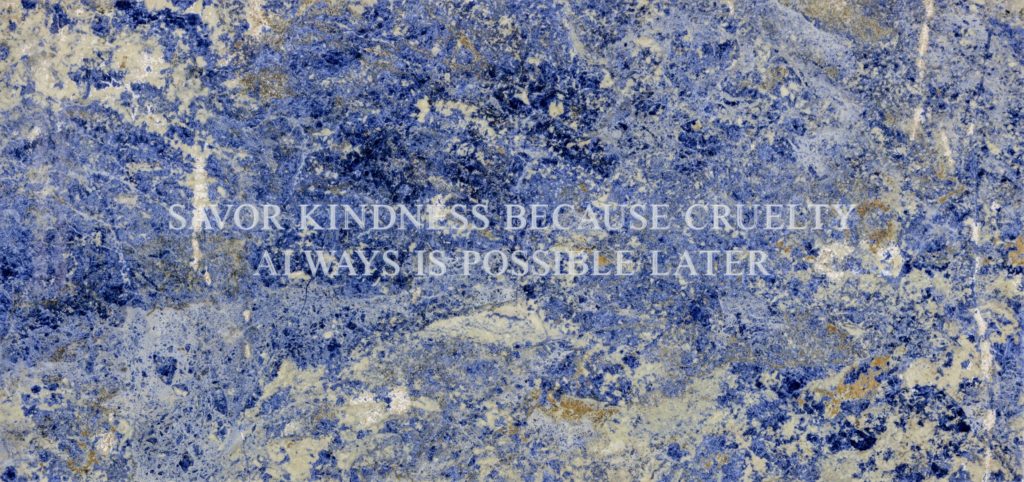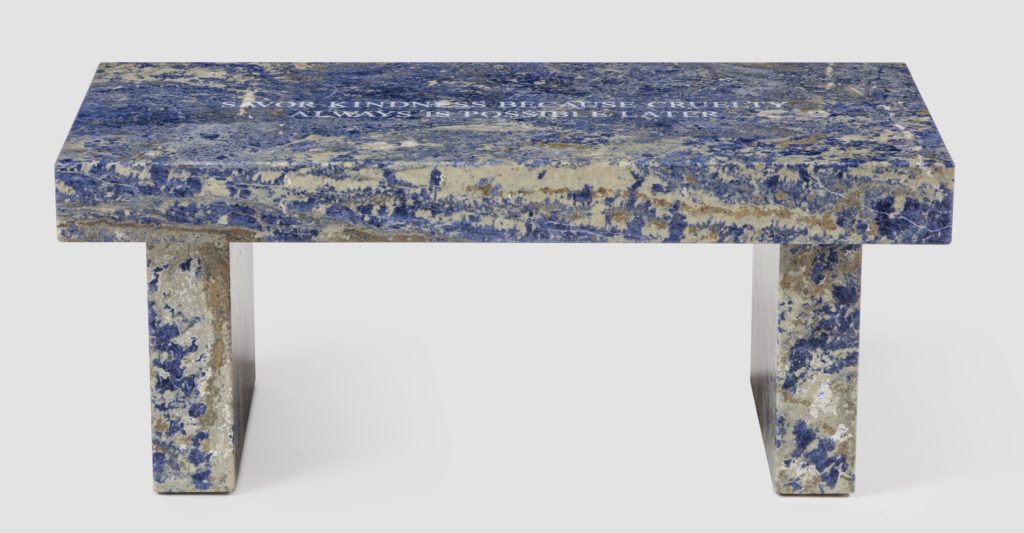People
‘I Can See Empty Space as a Three-Dimensional Solid’: Artist Jenny Holzer on How She Fuses Architecture With Language
What makes a good Truism? It has to do with both where it's seen and what it says.

What makes a good Truism? It has to do with both where it's seen and what it says.

Randy Kennedy

Randy Kennedy, Hauser and Wirth’s director of special projects and editor of Ursula magazine, shares an affinity for language with Jenny Holzer. The two of them dissect how this manifests in her practice in this interview, which appears in Hauser & Wirth’s new publication for Art Basel 2019, Conversations With Contemporary Artists, a selection of interviews between gallery staff and artists.
As a lifelong writer and editor, I guess I’m naturally partial to language-based artists. And so I’ve always wanted to ask you how you came to that particular kind of aphoristic, oracular, darkly comic language that defined your early career, in the posters you pasted anonymously on the streets in SoHo beginning in the late 1970s for the Truisms series.
Well, I decided I had to go for what was short, an important consideration because I knew I wouldn’t have much time with people who are walking or jogging by, hurrying somewhere. People need to see a few good words that make them pause. I wanted the writing to be like real Truisms and clichés, which tell us to what to do or communicate truths that don’t always add up. It was helpful, when writing fake Truisms, to represent multiple voices, many of them contradictory.
Why was it important to you in the beginning to do that anonymously?
It was anonymous partly because I was, as a person and as an artist. I thought of myself as essentially anonymous, and I didn’t sign because I wanted people to concentrate on the content. Also—I guess this goes to psych-ward stuff—I just don’t like people knowing too much about me, so anonymity fit my personality. Of course, there’s the woman thing. I didn’t want the work to be rejected out of hand by people who’d know it was by a young woman, people who would filter out the content for that reason, operating on immediate assumptions.

Jenny Holzer, Selection from Survival: Savor kindness… (2015). Photo: Joshua White.
Later, when the language you used began to shift away from your own, toward quotation and poetry, did that happen because you felt the Truisms had run their course (you once spoke of wanting to be “freed” from your own writing) or because there were certain kinds of meaning in quotation you felt you couldn’t get at through your own expression?
It began in part because I started working on memorials and permanent public pieces, and I felt that my writing wasn’t adequate for the projects, often because the person honored was a real writer or because the histories I was tapping were not ones about which I had adequate knowledge. For the Bundestag project in Berlin in 1999, for the politicians’ entrance, I went into archives to find text of speeches given there and at the Reichstag over more than a century. That’s what started me going elsewhere for language: to get around my modest abilities.
Given that many of your own pieces of writing have proven to be fairly prescient and widely quoted, do you really feel that writing is not a strength?
I think I’m okay at picking subjects. “Abuse of power comes as no surprise.” That’s still pretty much on topic! But I don’t see myself as a writer or a poet. I see myself as an artist and a painter. I was so very lucky to get direction toward certain poets from Henri Cole, who was executive director of the Academy of American Poets and who has been a collaborator of mine. Wisława Szymborska became a touchstone. Another person who came to me courtesy of Henri is Anna Swir, also a stellar Polish poet. Her work makes me levitate, transports me, especially her collections Talking to My Body and Building the Barricade. A poet who can write so well about sex and love and her thighs and also about the Warsaw Uprising is someone with what I’d call a pretty incredible range. I should add I discovered that poetry turned out to be especially suitable for light projections, which I love.

Jenny Holzer, Selection from Survival: Savor kindness… (2015). Photo: Joshua White.
It seems to me that more so than Lawrence Weiner and maybe even more than Barbara Kruger, certainly more than other language-focused artists like Bruce Nauman and Glenn Ligon, yours has always taken on architecture, power structures. Why do you think you’ve been focused, almost from the beginning, on the conjunction of language and the built world?
I confess to really, really liking architecture. And perhaps my only unusual skill is that I can see empty space as a three-dimensional solid. It’s an odd talent, but it’s helped me find ways to operate in fantastic buildings. I adore making space visible, tinting the air with electronic light for example. That to me is a good time. And I adore buildings that are great surprises, Frank Lloyd Wright’s Guggenheim, Frank Gehry’s Guggenheim. What a dandy thing to get to work with these buildings, on them and inside them. But, as you point out, other buildings are 3-D autocrats that need to be spoken to and upon.
The paintings you’ve been developing for years now, based on official documents—some heavily redacted, many having to do with the United States’ presence in the Middle East—seem to be moving more toward abstraction. Will they always have a foot, or at least a toe, in the linguistic and the political?
I’ve never liked some art that’s too much about other art. It kills my patience, so I don’t want to go too far down that road. But having said that, I admit that the art part of the document painting is fun, finding redactions that look like Russian Suprematism or pouncing on marks that resemble Abstract Expressionism or some kind of renegade Minimalism. If we’re going for the ratio of art versus content, an ideal could be about 50/50, but that varies from painting to painting. I have a copy of a page on my desk right now where the only word remaining is “endgame”—it’s from a CIA document about torture. Lately I’ve been working with content related to the Mueller Report and documents from the prosecutions, which brings us right up to now… The circus, coming to your town!